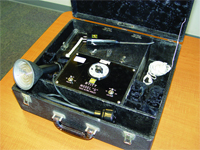
 This
This
challenge comes to us from Steve Zoltai, again, from the CMCC library.
If you can identify the unit that he is featuring for us, this issue,
please contact him at szoltai@cmcc.ca or contact the editor of Canadian
Chiropractor magazine at mdidanieli@annexweb.com. We will print your
answers in our upcoming February issue.
 This challenge comes to us from Steve Zoltai, again, from the CMCC library. If you can identify the unit that he is featuring for us, this issue, please contact him at szoltai@cmcc.ca or contact the editor of Canadian Chiropractor magazine at mdidanieli@annexweb.com. We will print your answers in our upcoming February issue.
This challenge comes to us from Steve Zoltai, again, from the CMCC library. If you can identify the unit that he is featuring for us, this issue, please contact him at szoltai@cmcc.ca or contact the editor of Canadian Chiropractor magazine at mdidanieli@annexweb.com. We will print your answers in our upcoming February issue.
This is my favourite piece of equipment from the archives. It’s both elegant and curiously archaic looking as well as a mystery as to how it operated and what it was intended to do. There are only three things we know for sure:
1. It is deceptively heavy though not particularly large (it sits on a wood-framed, marble base).
2. It looks vaguely sinister.
3. It was intended to generate sine waves. The only surviving note that we have identifying the instrument states that it is a "therapeutic current AC-DC generator/high frequency static generator." The device has a setting dial labelled "No. 2 Polysine Generator."
Moving clockwise, the dial can be set to three AC modalities: surging wave, surging sinusoidal or rapid sinusoidal. Counter-clockwise, the dial can be set to three DC modalities: galvanic, slow sinusoidal and surging
galvanic. The setting dial is flanked by two adjustable rheostats and a central dial measures the electrical output in milliamperes.
| The mechanical housing to the upper right appears to be a generator.
A red-tinted light bulb flanks the generator and is presumably there to indicate the strength of the current. On the other hand, it could only be there for show. An electrical cord extends from two connections at the back of the device. These connections are labelled AC. There are two additional connections at the back of the machine labelled PDCN. Presumably these connections had something to do with the DC current or may have been used to connect some additional piece of the equipment that could have come in contact with the patient. The machine is identified as manufactured by McIntosh, Chicago. No date of manufacture is given, though my guess would be 1920s or earlier. I'd be greatly appreciative if our readers could give us some insight into how this machine worked, what its intended therapeutic use was and some better idea of its age. Steve Zoltai
Dr Tim Kunkel thinks he has the definitive answer to Photo 1 in our September Chiropractic History Assignment. The reason he thinks he knows what the unit is is because he has two of them. Apparently they are oscillating condensators. He had two portable versions of them custom built in India while he was there studying acupuncture and homeopathy in 1978. They were built in New Delhi through the Mahatma Gandhi Ashram Institute. The unit consists of argon filled tubes of different shapes that attach to a hand held device. Once the unit is plugged in, the electrical current activates the argon in the tubes and the gas in the tube will glow purple like Luke Skywalker's light sabre. ("Let the Innate Force be with you" quips Dr Kunkel.) When the tip of the attachment is brought close to the affected area it will create an electrical arch which, he assures me, was not entirely painless. The flat-headed, bulbous attachment shown in the hand held unit was used to treat skin disorders such as acne and psoriasis. The pointed attachment at the top of the case was the most frequently used and was used for trigger point therapy, acupuncture-type treatments as well as such diverse uses as relieving the swelling in goiter and to activate nerves in patients with MS. The third attachment was designed for para-spinal musculature while the metal tube at the bottom is for reactivating the gas if the tubes had been unused for some time. The upper dial is for intensity, the lower is for current. Dr. Kunkel has donated the unit to the library and it is now on display in our museum exhibit. For helping to clear up this mystery I think Dr. Kunkel deserves an "A" for his chiropractic history assignment |
Print this page
 An “A” goes to Dr Tim Kunkel for his response to the Chiropractic History Assignment in our September issue!
An “A” goes to Dr Tim Kunkel for his response to the Chiropractic History Assignment in our September issue!